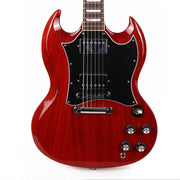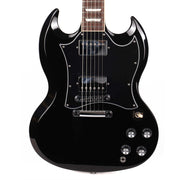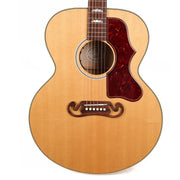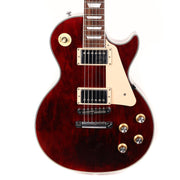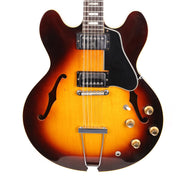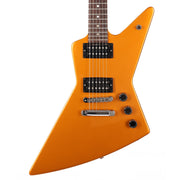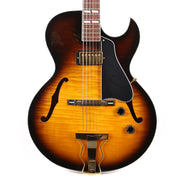Gibson Firebird X Coming September 30
In just a few weeks Gibson will drop their latest technology-packed USA solidbody guitar onto the scene: the Firebird X. This guitar won’t be available for purchase directly on our website, but we will have them in stock in the store so come take a test drive. The Firebird X expands on the concepts introduced with the original Robot Guitar, including the robotic tuners. There are built in effects, a tuner, a piezo pickup (in addition to the three mini-humbuckers), and an onboard chipset from Freescale that is user replaceable to help keep the tech-y side of the guitar future proof. The Firebird X promises a lot of innovation, and we’re looking forward to get our hands on one. After the jump, pictures and specs galore.
From Gibson.com:
The Firebird X System
All capabilities must be simple to use – an extension of the way a guitar player thinks about his current guitar and rig. Our design goal is to bring more creative options to the player while he or she is playing. Thus the user interface will become richer and simpler. Fundamental musical effects will now become available with a minimum of motion and disruption from playing the music. At the same time, the player will be able to see what is happening with the guitar environment very easily, again without disrupting his making music.
BODY CONSTRUCTION
The guitar is made to be comfortable and amazingly easy to play. It features a lightweight body made from hand-sorted swamp ash, with a rock maple neck and curly maple fingure board. This construction not only makes it refreshingly light (allowing you to play for many hours without even noticing), but it also allows the guitar to achieve exceptional sustain and tonal range. Firebird X is capable of very resonant and acoustic-like voicing.
The guitar is a bit more than six pounds in total weight. Special resonant chambers not only decrease total weight, but also allow acoustic-like tones and increased overall sustain. The guitar is louder than a typical solid body with substantial tone from lowest bass note to highest treble note. To get more depth, we use a heavy bottom gauge of string with E being about “10” and low E about a “52” with a custom gauge insuring even, crisp tones for all six strings.
This guitar is clearly evolved from a Gibson Firebird, evocative of a rich history, but with contemporary features. With its hand-applied and unique high-end wood finish, the Firebird X is not unlike a cross between a vintage sports car and a modern sports racer. It is beautiful, historical and yet contemporary and unique. With a limited run of just 1,800 units, it is sure to become a collector classic.
Scarfs and large radius corners are everywhere the arm and body come into contact. It is smooth and comfortable, even when you are playing for hours. It’s almost not there.
BALANCE – WITH STRAP AND SITTING
The balance point for the upper bout and the lower curve for placement on the leg are exceptionally balanced and comfortable. This is a guitar you can play for hours without soreness or fatigue.
We have developed a patent-pending strap that attaches at the upper bout with a single strap lock that comes with the guitar. That strap is much more comfortable, evenly distributing the lightweight beast and allowing complete freedom of motion. A simple adjustment allows you to adjust the hanging height on the fly. Both strap buttons are available if you desire a more traditional hang.
THE AESTHETICS – THE LOOK
The look builds on the Firebird’s and Gibson’s history. The wood grain is accentuated, so it “pops” with staining technique.
The fingerboard has character with a slightly burnt maple look. The neck inlays are tilted parallelograms, with a very dark wood. The headstock has a classic Gibson dove wing shape, which is bound, and a Firebird-style truss rod cover.
The look has a very classic fine furniture look with marquetry, elegant curves and smooth rounds. It is very appealing to a guitar player and non-guitar player alike.
NECK
The neck is thin, fast, and asymmetrical with a smooth, non-stick satin finish. A volute at the nut allows the hand to quickly find the first position and improves total sustain and strength. The neck joint is smoothly blended from neck to body with just a slight roundness, allowing maximum access to high register strings. The lower cut away cuts deeper, affording exceptional access to the high register.
The fingerboard has low-profile, fretless wonder frets and a highly polished curly maple surface.
This allows fretting to have almost no impact on pitch (higher frets cause a slight pitch change when the finger depresses the string). Finally, the fretboard is extended to 23 frets, allowing the player to achieve a full, two-octave range with a bend.
The maple neck is hand-sorted and is exceptionally stable, allowing previously unachievable tolerances on our factory set up and maintaining this great set up over time.
PICKUPS
The Firebird X product uses three mini-humbuckers and a vastly improved hexaphonic piezo bridge pickup with an improved low noise, high dynamic-range preamplifier, making this a fully active guitar. The pickups are based on traditional Firebird designs, but have been significantly improved to provide more tonal range and to match the studio-grade preamplifier section. The result is that the signal dynamic analog dynamic range exceeds the specification of the high-end electronics — 110 dB.
Each coil of the electro-magnetic pickup is individually controlled, allowing each coil to be on, off, or on-reverse polarity. The guitar’s presets use the best combinations to recreate the world’s best tones and some great new tones. New combinations can be made using the Firebird X editor, giving you an unlimited sonic palette.
Turbo Charged “Pure-Analog™” Engine
The heart of this high-performance beast is a high-performance multi-processor from Freescale. This is the same chip family used in ProTools systems, except this engine is the latest and greatest and overpowers older Pro Tools set-ups.
THE ENGINE IS A PLATFORM BUILT TO NEW UNIVERSAL STANDARDS
This powerful, turbo-charged sound processor is designed to give the maximum advantage and flexibility to the guitar player. The Pure-Analog™ engine is designed to a new Gibson standard, which makes the engine user-replaceable. When you want to upgrade, the little package encased in metal is removable and a new one can be installed in under one hour. Part of the standard is a standard connector (no soldering required) that has pin outs, allowing the most complex guitar designs with many pots, switches and pickups to be accommodated.
These standards future-proof your investment and will allow third parties to supply their own solutions.
The new size standard will allow this engine to be used with any guitar body, including our most space-challenged. By standardizing the sound processor engine form factor, we can also achieve far higher volume by allowing it to be used in many different types and models of guitar and bringing the cost of this powerful technology down very quickly.
PURE-ANALOG™ SECRET SAUCE — NOT A MODELING GUITAR
This guitar is pure analog, starting with the tuning. Unlike competitors, who use sterile digital math to “correct” pitch and achieve different tunings, we actually tune the strings to very accurate pitches. You get 100% analog with the added benefit of hearing the same pitch coming from the guitar acoustically, or through your amplifier.
This pure analog signal then goes directly into a studio quality preamp, which ensures maximum dynamic range. Since all this activity takes place in the guitar, we use shielded cables, metal enclosures, and other special manufacturing methods to virtually eliminate noise from either external sources, or internally generated distortion.
Our engineers’ attention to detail results in the quietest, highest dynamic range guitar ever built.
We then use high performance ADC chips to convert the audio stream into the digital form on which our sound processor can act with virtually no latency. Inside our engine we maintain the signal stream with high internal precision. What this means is that every effect or operation has such a fantastically high bit depth and resolution that there are virtually no truncation errors or other artifacts, truly preserving the analog quality of the original signal. The signal starts as fantastic analog, and leaves as fantastic analog, using an exceptional DAC. Everything that happens in between is Gibson Pure-Analog™.
It is not enough to get the analog authenticity that all players lust for. A large part of the analog sound is the way analog equipment functions, which is very different from the implementation of sterile digital mathematical formulas. Like a drum machine compared to a live drummer, real life has enormous texture and non-mathematical nuance. Gibson designers are guitar players with decades’ worth of experience. We have studied this very real mojo and added it to every part of what our engine does. These many techniques allow us to achieve Pure-Analog™ that even the most discerning ears will agree is an analog sound.
BEST IN CLASS ONBOARD EFFECTS—GOLDTONE FX™
Our design goal was not to duplicate other effects, but to create unique, very analog-type tones with a lot of warmth that we call Goldtone FX™. The Firebird X comes with a variety of patches, many of which approach some sounds from famous gear rigs, but our patches have their own character.
Our patches are not aimed at eliminating outboard gear, although many players will be very satisfied with the huge creative range we allow. Our Goldtone FX™ plays very nicely with other gear — surprisingly nicely.
The Firebird X guitar has two significant effects that have been made part of the instrument:
Usually tube distortion has a very characteristic harmonic quality, but it is very dependent on the rest of the gear being used. Even different amplifiers with the same tube circuits and tubes can sound very different. Because all processing takes place in the guitar, we can consistently achieve distortion exactly the way you want it, every time.
Our Goldtone FX™ captures the analog essence (tube mojo), but allows you to adjust the basic character of the distortion. With a three-way toggle switch, you can immediately dial up three aspects of distortion — compression, distortion and EQ — each controllable in real time with three sliders.
| TOG-POT 2 | DESCRIPTION | FADER 1 | FADER 2 | FADER 3 |
|---|---|---|---|---|
| POSITION UP | Compression | Sustain | Attack | Noise Gate Level |
| POSITION MID | Distortion | Overdrive | Bite | Type |
| POSITION DOWN | EQ | 800 Hz | 2200 Hz | 10000 Hz |
| Rotation Control = Strength of Effect (0% Dry — 100% Wet) | ||||
| Each of the sliders has a broad range to dial in just the right sound. The most interesting slider is Type, which basically allows a sweep through the personalities of many of the distortion rigs currently in use and then some more. |
| TYPE | |
|---|---|
| 1 | FatStack |
| 2 | Brit Overdrive |
| 3 | American Dual |
| 4 | Rock Stack |
| 5 | Shred |
| 6 | NuMetal Scoop |
The rotating shaft allows you to dial in the strength of the effect patch similar to the way a wet/dry control works on a mixer. At zero, there is no effect to full rotation being 100%. Thus you can dial in exactly how much you want and adjust it real-time.
The next group of effects is the EchoPlex group – Modulation, Delay, and Reverb. These three effects can be individually controlled and dialed in, but act in series allowing a huge tonal palette.
| TOG-POT 3 | DESCRIPTION | FADER 1 | FADER 2 | FADER 3 |
|---|---|---|---|---|
| POSITION UP | Modulation | Depth | Speed | Type |
| POSITION MID | Echoplex | Delay Time | Feedback | Tape Character |
| POSITION DOWN | Reverb | Decay | Feedback | Type (Spring to Lush) |
| Rotation Control = Strength of Effect (0% Dry — 100% Wet) | ||||
The type slider is able to dial in various types of the effects.
| MODULATION | TAPE ECHO | REVERB | |
|---|---|---|---|
| 1 | Chorus | Digital delay | Spring |
| 2 | Phaser | Analog delay | Plate |
| 3 | Vibrato | Tape echo | Room |
| 4 | Tremolo | Modulated delay | Hall |
| 5 | Flanger | Dynamic delay | Gated |
| 6 | Reverse delay | Dynamic |
The tog-pot rotary allows you to dial in just how much of the effect you want.
This is the complete effects chain. Note that there are many more effects modules that can be used to develop patches than those mapped to the controls on the guitar.
These additional effects can be fully controlled by the software editor, which comes with the Firebird X. It allows you to design your own patches and save them as computer files and load them into bank/patch locations that make sense to you. The sonic palette this allows is mind-boggling.
Finally we have a tog-pot that is dedicated to more advanced program control. This tog-pot does not have sliders/faders, but controls more complex guitar functions.
PATCH PLAY MODE
The Firebird X is very simple to use. The default playing mode of the guitar is called “Patch Mode.” This means that different voices are accessed by turning the Gear Shift Knob to select a bank of voices, and the 5 position switch to choose a specific voice. That is it!
The volume and tone knob work as does the function of the Gray Tog Pot, but all other controls are not operative. This insures that you do not accidentally change any of the voice settings, regardless of how intensely you are playing.
The foot pedals always work and their function is available at all times, since it is much more difficult to accidentally trigger either foot switch.
LIVE EDIT MODE
Live Edit Mode turns on all tog-pot functions and sliders and allows you to alter the patch/voice you have called up, and save those changes.
You enter the Live Edit Mode at any time by simply pressing the tone pot twice. The Gear Shift Knob will blink several times indicating you are in Live Edit Mode and LED display on the Number Foot Pedal will also indicate you are in Live Edit Mode.
When in Live Edit Mode, you can change any of tog-pots and slider settings until you get the voicing you are searching for. The physical positions of the tog-pots and sliders may not correspond to the actual parameters in the patch/voice. When you change a tog-pot or slider physically, that tog-pot or slider will change to the physical position of control.
|
|
The factory (or user) defaults are always preserved when a new voicing is saved using Live Edit mode. Thus you can always return to the default voice and delete the new voicing. The guitar comes with some really great factory voicings, but the user can change the defaults using the Computer Guitar Voice Editor.
PIEZO BLEND
In the default middle position, the rotary motion controls the amount of piezo signal that is added to the signal path. In other words, this is a piezo blend pot that blends the piezo sound with the electromagnetic pickup sound. It adds a very acoustic-like brightness to the sound palette for an authentic acoustic guitar tone.
| TOG-POT 1 | DESCRIPTION | |
|---|---|---|
| POSITION UP | PU or Program Mode | |
| POSITION MID | Piezo Blend | |
| POSITION DOWN | Tuning | |
| Rotation Control = Strength of Effect (0% Dry — 100% Wet) | ||
TUNING
A simple push downward puts you into tuning mode. The last tuning setting is the default, to allow you to bring the guitar back to perfect pitch quickly at any time. Strumming the open strings rapidly and lightly gives the guitar tuner the input it needs to get back to pitch. The guitar is muted while it is tuning and releases the mute as soon as it is tuned. Typically this takes two or three strums. The guitar also goes back to the piezo blend state to prevent accidentally causing further robo-tuner motion. The switch is still down, so it should be moved back to mid position at your convenience.
The Gear Shift Knob shows the state of the strings while you are tuning, although tuning happens so quickly this is rarely useful.
PU or PROGRAM MODE
When the toggle switch is pushed up, the guitar turns the 5-position switch to a pickup selector, allowing you to choose five possible pickup combinations without changing otherwise your effects patch. When you move the Gear Shift Knob, or move this tog-pot switch, the guitar reverts to the mode the guitar was in previously.
A LOT OF TONE IS ABOUT EQ AND OURS IS OUTSTANDING
Gibson has done substantial research on what makes acoustic tones sound the way they do, going back to work with University of California, Berkeley in the ’80s. One of our key findings was that a frequency curve gave close to 90% of the perceived signature tone information. In our last two high-technology guitars, we used a four band parametric EQ to sculpt the tone curve, with a plus/minus 12 dB range. That worked well, but fell short of the range of human hearing.
Most studios will use either graphic or parametric EQ’s extensively, but rarely with more range than our previous high-tech guitars. The problem is that boosting or cutting more than about 15 dB causes significant distortion, level and other signal chain problems. We compensate for the change in each individual band to maintain the same output level, and maintain maximum dynamic range within the EQ processing with a proprietary algorithm. This allows us to achieve the full range, that the human ear can discriminate, and some really awesome tones.
We have numerous parametric EQ’s in our signal chain that have six bands with a range of plus/minus 36 dB.
| FADER 1 | FADER 2 | FADER 3 | FADER 4 | FADER 5 | FADER 6 | |
|---|---|---|---|---|---|---|
| FREQUENCY | 200 Hz | 800 Hz | 2200 Hz | 10 kHz | 15 kHz | 16 kHz |
| Q | 0 to 20 | 0 to 20 | 0 to 20 | 0 to 20 | 0 to 20 | 0 to 20 |
| TYPE | Low Pass | Notch | Notch | Peak | Notch | High Pass |
| WE BRING YOU THE FOURTH DIMENSION IN INSTRUMENT DESIGN — IT’S ALIVE |
| Modern electric guitars have three dimensions. The first dimension is the physical mechanics of guitar construction. This consists of the type of wood, the guitar scale, the string composition, etc. The physical parameters resulted in a distinctive tone. The mechanics of the guitar generally only allow one tone. |
| In the 1920s and commercially in the 1930s, a second dimension was added with pickups and radio-style tone controls. Gibson’s Lloyd Loar was an early pioneer with electrified instruments fully 10 years ahead of competitors like Rickenbacker. |
| http://www.siminoff.net/pages/loar_contributions.html ; http://en.wikipedia.org/wiki/Lloyd_Loar |
| Lloyd was followed by Walter Fuller and Seth Lover, who began to perfect radio-style tone controls and the amplifiers which added a new component in the signal chain. The addition of amplification and electrical components allowed the same guitar to have many different voices. |
| http://www.premierguitar.com/Magazine/Issue/2009/Oct/Anatomy_of_a_Classic_Gibson_1949_GA_CB.aspx |
| It was Les Paul who brought the third dimension to guitar players. Les’s experience with early tape machines culminated in two years of intense work from 1946 to 1948, and a black box effect he called the “Les Pulverizer” was born. He used this first guitar effect to create a signature sound, which was showcased on the first nationally televised music video show in 1950. This was fully 10 or more years before engineers like Tom Oberheim, working for the Maestro division of CMI, popularized guitar effects and stomp boxes. |
| http://ia311003.us.archive.org/1/items/LesPaulShow/LP-500330Audition.mp3http://masterofmypublicdomain.blogspot.com/2010/05/when-les-is-more.html |
| The problem with effect devices is they do not know what the input signal could be. It could be any guitar with a variety of impedances, or another effects device in a long chain. What Firebird X does is bring this signal chain into the guitar instrument. Firebird X knows exactly what the input is and allows the player to have easy, intuitive, real-time control of this third dimension. We can now design a guitar instrument to achieve many more optimum voices. Les had to do significant work before he used his effects on a song. While it looked real-time, he spent hours in the studio to develop the sound. With Firebird X, you don’t have to. |
| But we also introduce a fourth dimension in instrument design. Since the instrument has all the tone modifiers inside, and can sense exactly what the player is doing, it can do what all great acoustic instruments have done for centuries — react to what the player does. We have algorithms that respond to how you play and change what gets heard. Firebird X springs to life because it is working with you and taking you to new heights, rather than just adding some effects that are clinical and unchanging. You will immediately feel it and it will feel good. |
FIREBIRD X AND THE ONBOARD BOUNDARY MICROPHONE
A boundary microphone consists of a small condenser microphone mounted parallel or flush with a flat, smooth surface. Mounting a microphone in this manor has many advantages. Many regard the region close to a flat, smooth surface as the boundary or pressure zone. This region is where direct and reflected sound waves are effectively in-phase. By orienting the diaphragm flush with the surface, direct and reflected sound waves arrive at the microphone’s diaphragm at the same time. This eliminates phase cancellations and results in a smooth frequency response.
In addition to phase cancellations, boundary microphones have greater sensitivity, lower noise, and reach. Since the direct and reflected waves add together in phase, the sound pressure doubles at the diaphragm, giving a 6 db increase in sensitivity. When sensitivity and S/N are improved, quite distant sounds can be clearly picked up.
Since the reflect path length stays equal to the direct path length regardless of the sound-source position, there is no change in tonal quality as the source moves. This provides a natural un-colored reproduction of the sound.
FIREBIRD X MICROPHONE — FLUSH-MOUNTED UNDER THE TAILPIECE
Mounting a miniature boundary microphone under a guitar’s tailpiece is not ideal, but this position ensures that the player’s hand or arm will not completely cover the element during a measurement. It also protects the element from dirt and dust. Also, because of the low mass of the diaphragm, the microphone is less sensitive to mechanical vibrations that might occur in this application.
Measuring the frequency response of the microphone with and without the tailpiece allows us to identify the effect of the tailpiece and compensate in the DSP for a flat response, if necessary. A microphone with a smooth, flat, uncolored response will allow us to sample the true ambient environment and provide accurate data for necessary adjustments.
AMBIENT CONDITIONS FROM GUITAR MICROPHONE
A player adjusts the guitar based on what he/she hears. In more professional cases, like an arena gig, there are sound people that adjust the instrumental mix regardless of what the guita





